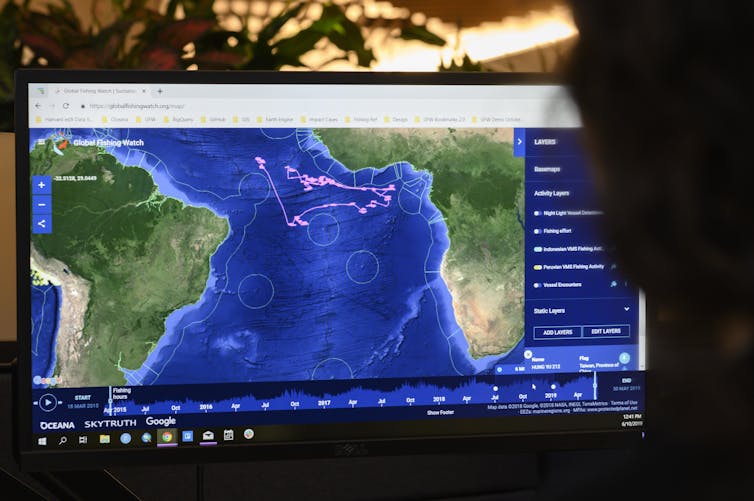By Julie Cohen
Santa Barbara, USA.- Fishing activity now covers at least 55 percent of the world’s oceans — four times the land area covered by agriculture — and can now be monitored, in near real time, to the level of individual vessels. In fact, 70,000 vessels of the global fishing fleet traveled 460 million kilometers in 2016, equivalent to traveling to the moon and back 600 times.
Using satellite tracking, machine learning and common ship-tracking technology, scientists from UC Santa Barbara teamed up with colleagues at Global Fishing Watch, National Geographic Society’s Pristine Sea project, Dalhousie University, SkyTruth, Google and Stanford University to illuminate the extent of global fishing — down to single vessel movements and hourly activity. Their findings appear in the journal Science.
“I think most people will be surprised that until now we didn’t really know where people were fishing in vast swaths of the ocean,” said co-author Christopher Costello, a professor at UCSB’s Bren School of Environmental Science & Management. “This new real-time dataset will be instrumental in designing improved management of the world’s oceans that is good for the fish, ecosystems and fishermen.”
While the dataset is hundreds of times higher in resolution than previous global surveys, the total area of the ocean fished is likely higher than the 55 percent estimated. That’s because some fishing efforts in regions of poor satellite coverage or in exclusive economic zones with a low percentage of vessels using the automatic identification system (AIS) were not included.
The team used machine learning technology to analyze 22 billion messages publicly broadcasted from vessels’ AIS positions from 2012 to 2016, to answer the question, “What drives commercial fishing behavior?” Based solely on vessel movement patterns, the Global Fishing Watch algorithm was able to identify more than 70,000 commercial fishing vessels, the sizes and engine powers of these vessels, what type of fishing they engaged in, and when and where they fished down to the hour and kilometer.
This new global view of fishing draws on advances in satellite technology and big data processing.
Stay Always Informed
Join our communities to instantly receive the most important news, reports, and analysis from the aquaculture industry.
More than 40 million hours of fishing activity was observed in 2016, and while most nations appeared to fish predominantly within their own exclusive economic zones, China, Spain, Taiwan, Japan and South Korea accounted for 85 percent of the observed fishing on the high seas.
“This dataset provides such high-level resolution on fishing activity that we can even see cultural patterns, such as when fishermen in different regions take time off,” said co-author Juan Mayorga, a project scientist in the Sustainable Fisheries Group at the Bren School and with NatGeo’s Pristine Seas. For example, in the Chinese fishing fleet — the largest in the world — during Chinese New Year fishing activity is reduced to levels comparable to those during seasonal bans enforced by the government.
The investigative team also found that when and where fishing occurs are tied more to politics and culture than to natural cycles such as fish migrations and marine food production. “Our analysis demonstrated that policies, cultures and economics play a huge role in driving fishing behavior,” Costello said.
“In addition, we examined whether fishing diminished when fuel prices were high and found a weak response,” he added. “These are the kinds of things about which we’ve always speculated but haven’t ever been able to test — until now.”
The resulting interactive map — which is freely available to the public — shows a near real-time view of the fishing patterns of individual vessels and fleets. This allows anyone to see what is going on in their own backyard and to observe where policy boundaries are in place and where they are not.
“By making this data public, we are providing governments, management bodies and researchers with the information needed to make transparent and well-informed decisions to better regulate fishing activities and reach conservation and sustainability goals,” Mayorga said.
The study not only opens a gateway for improved ocean management but also confirms that fishing activity is clearly bounded according to differing management regimes, which indicates the role that well-enforced policy can play in curbing overexploitation.
“This collaboration opens up myriad research opportunities,” Costello explained. “We are leveraging the products developed by Global Fishing Watch to address new and important research questions that will improve fisheries sustainability around the world.”
Global Fishing Watch Vessel Tracking Map: http://globalfishingwatch.org/map/
Reference:
David A. Kroodsma, Juan Mayorga, Timothy Hochberg, Nathan A. Miller, Kristina Boerder, Francesco Ferretti, Alex Wilson, Bjorn Bergman, Timothy D. White, Barbara A. Block, Paul Woods, Brian Sullivan, Christopher Costello, Boris Worm. Tracking the global footprint of fisheries. Science, 2018; 359 (6378): 904 DOI: 10.1126/science.aao5646
http://science.sciencemag.org/content/359/6378/904
Source: UCSB
Editor at the digital magazine AquaHoy. He holds a degree in Aquaculture Biology from the National University of Santa (UNS) and a Master’s degree in Science and Innovation Management from the Polytechnic University of Valencia, with postgraduate diplomas in Business Innovation and Innovation Management. He possesses extensive experience in the aquaculture and fisheries sector, having led the Fisheries Innovation Unit of the National Program for Innovation in Fisheries and Aquaculture (PNIPA). He has served as a senior consultant in technology watch, an innovation project formulator and advisor, and a lecturer at UNS. He is a member of the Peruvian College of Biologists and was recognized by the World Aquaculture Society (WAS) in 2016 for his contribution to aquaculture.




